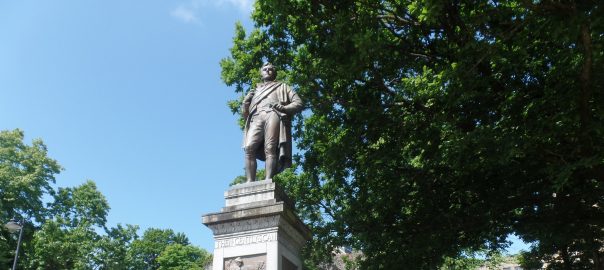Last May my husband Will and I saw the John Steinbeck play, Of Mice and Men, at the Leeds Playhouse in England. This theatre experience was different from our one the previous week in London. Tickets in Leeds were about a quarter of the London price. That Tuesday the Leeds theatre was a quarter full and we were probably the only non-Brits present. In London we packed the theatre with a large number of tourists.
Of Mice and Men is set in the United States during the Great Depression. It tells the story of two migrant workers who dream of owning their own farm. Being Steinbeck, their dream turns to tragedy at the end. Before seeing the play, I wasn’t familiar with the story, but afterward references to the novel kept popping up. This began later in our holiday, when we visited Alloway, Scotland, the birthplace of Robert Burns, who is widely regarded as Scotland’s National Poet.

Burns birthplace cottage, Alloway, Scotland
Viewed as a poet of the working class, Burns wrote in a light Scots dialect. He’s affectionally called Rabbie by his Scottish fans. Of course, we’d sung his song/poem Auld Lang Syne on numerous New Year’s Eves, but on this visit we learned that another Burns’ poem, To a Mouse, was the inspiration for Of Mice and Men. Burns wrote the poem after he accidentally destroyed a mouse’s nest with his plough and realized that, with its nest gone, the mouse wouldn’t survive the winter. These lines inspired Steinbeck:
The best laid schemes o’ Mice an’ Men
Gang aft agley,
An’ lea’e us nought but grief an’ pain, For promis’d joy!
When I returned home from my trip, a library book I’d put on hold was waiting for me: Prince Harry’s memoir Spare — I confess I read it. While discussing his teenage lack of interest in literature and academics, Harry says the one book that grabbed him was Steinbeck’s Of Mice and Men, which was assigned in his English class. He liked that the book was short and, unlike Shakespeare, the plain language didn’t need a translator. Most of all he could relate the story’s themes of friendship, brotherhood, and loyalty to him and his brother William. The brothers’ story ebbs and flows through Harry’s memoir and crashes at the end.
In 2009 Burns was voted the greatest Scot by the Scottish public in a contest hosted by a Scottish TV show. Since then Burns has run into criticism. Some feminists interpret his lusty poems and lifestyle as sexist. He had twelve children by four women. Seven were illegitimate, including the first four by his wife Jean Armour. By Scottish law they became legitimate after the marriage. According to a museum plaque, Jean raised one of the illegitimate children born after she and Rabbie married — it gets complicated.

Others criticize Burns for accepting a job as bookkeeper for a Jamaica slave plantation. In the end, he didn’t go to Jamaica for personal reasons.
It might also be that the Scots dialect in Burns’ poems has fallen out of favour with younger readers, like Shakespeare’s language for Prince Harry, and doesn’t resonate with an increasingly diverse public.
But many Scots around the world still adore Burns and celebrate his birthday, January 25, at Burns’ dinners, which traditionally include such iconic Scottish features as a bagpiper greeting guests and a whisky toast to the haggis.

